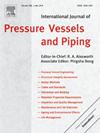Probabilistic mechanical assessment of ABWR feedwater piping to identify fractures using plant-specific parameters
IF 3
2区 工程技术
Q2 ENGINEERING, MECHANICAL
International Journal of Pressure Vessels and Piping
Pub Date : 2025-02-08
DOI:10.1016/j.ijpvp.2025.105456
引用次数: 0
Abstract
This paper firstly proposes a statistical framework for evaluating the structural integrity of the feedwater piping of an advanced boiling water reactor with ASME III Class I piping design specification, in order to confirm its operational reliability. The process initially involves a design stress reanalysis based on the pressure piping design requirements of Article NB-3600 for ASME III Class I components to determine the sustained and vibratory stresses at node points. Plant-specific parameters of the piping system, such as pipe geometries, static and dynamic (seismic and hydrodynamic) loads, and design transients, were taken from the original design report. Moreover, the accepted results of detailed forces and moments that were obtained from the design stress reanalysis were the input data for a probabilistic fracture mechanics analysis that considered the effects of design stress, crack distribution and inspections on pipe failures. Leak probabilities at individual piping weld joints due to the growth of pre-existing and initiated cracks by the typical aging degradation mechanisms of fatigue and stress corrosion cracking were predicted as a function of time. A numerical investigation proved that the results of two-step analyses agree quantitatively to a certain extent. Based on the assessment, the failure risk of piping system is clarified and can be regarded as the basis of relevant safety regulations and subsequent maintenance activities during the operation of a nuclear power plant.
利用电厂特定参数对ABWR给水管道进行概率力学评估以识别裂缝
本文首先提出了一种基于ASME III I类管道设计规范的先进沸水堆给水管道结构完整性评估的统计框架,以确定其运行可靠性。该过程最初涉及基于ASME III类I部件的第NB-3600条压力管道设计要求的设计应力再分析,以确定节点处的持续和振动应力。管道系统的工厂特定参数,如管道几何形状、静态和动态(地震和水动力)载荷以及设计瞬态,均取自原始设计报告。此外,从设计应力再分析中获得的详细力和弯矩的可接受结果是概率断裂力学分析的输入数据,该分析考虑了设计应力、裂纹分布和检测对管道失效的影响。在典型的疲劳和应力腐蚀裂纹老化退化机制下,预测了单个管道焊接接头由于原有裂纹和初始裂纹的扩展而产生泄漏的概率。数值研究表明,两步分析结果在定量上有一定的一致性。在此基础上,明确了管道系统的失效风险,可作为核电厂运行过程中相关安全法规和后续维护活动的依据。
本文章由计算机程序翻译,如有差异,请以英文原文为准。
求助全文
约1分钟内获得全文
求助全文
来源期刊
CiteScore
5.30
自引率
13.30%
发文量
208
审稿时长
17 months
期刊介绍:
Pressure vessel engineering technology is of importance in many branches of industry. This journal publishes the latest research results and related information on all its associated aspects, with particular emphasis on the structural integrity assessment, maintenance and life extension of pressurised process engineering plants.
The anticipated coverage of the International Journal of Pressure Vessels and Piping ranges from simple mass-produced pressure vessels to large custom-built vessels and tanks. Pressure vessels technology is a developing field, and contributions on the following topics will therefore be welcome:
• Pressure vessel engineering
• Structural integrity assessment
• Design methods
• Codes and standards
• Fabrication and welding
• Materials properties requirements
• Inspection and quality management
• Maintenance and life extension
• Ageing and environmental effects
• Life management
Of particular importance are papers covering aspects of significant practical application which could lead to major improvements in economy, reliability and useful life. While most accepted papers represent the results of original applied research, critical reviews of topical interest by world-leading experts will also appear from time to time.
International Journal of Pressure Vessels and Piping is indispensable reading for engineering professionals involved in the energy, petrochemicals, process plant, transport, aerospace and related industries; for manufacturers of pressure vessels and ancillary equipment; and for academics pursuing research in these areas.

 求助内容:
求助内容: 应助结果提醒方式:
应助结果提醒方式:


